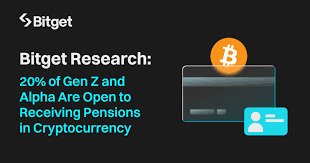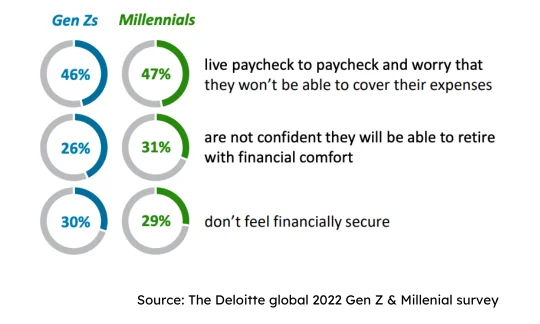Something’s changing — quietly, but unmistakably. A new generation of savers isn’t putting their money in dusty savings accounts anymore. Instead, they’re diving headfirst into the volatile, electric world of cryptocurrency.
For Millennials and Gen Z, crypto isn’t just an investment — it’s a statement. It’s about control, opportunity, and a little bit of rebellion against a system they feel never truly worked for them.
But what happens when your “savings” can swing 20 % in a week? Let’s dig into what’s behind this generational money shift — and what it might mean for the future of finance.

1. The Numbers Don’t Lie
Surveys tell a clear story.
A YouGov poll found that 42 % of Gen Z investors own crypto, while only 11 % have a traditional retirement account. Millennials aren’t far behind — 36 % say they own crypto, almost matching those with retirement plans.
The World Economic Forum reports that more than half of Millennials hold at least one-third of their portfolios in digital assets. Gen Z? Around 35 % have over half their portfolio in crypto. That’s not a fad — that’s conviction.
And globally, the numbers match the mood: Millennials make up about 40 % of all crypto users, Gen Z another 28 %. Together, they’re the heartbeat of the digital-asset movement.
Clearly, something big is happening.
2. Why Young People Are Choosing Crypto
Let’s be real — it’s not just about making money. It’s about how they make it, and what that says about who they are.
a) They Don’t Trust the System
Many Millennials grew up watching their parents struggle through the 2008 financial crisis. Gen Z came of age during inflation spikes, student-debt chaos, and pandemic uncertainty. The “safe and steady” financial system doesn’t feel safe or steady at all.
So when banks offer tiny interest rates and the cost of living keeps rising, crypto feels like… freedom.
b) It Fits Their Digital Lifestyle
Younger generations live online — they shop, date, and work online. So why wouldn’t they save online too?
Crypto apps are sleek, mobile-friendly, and built for instant access. Compared to the slow, paperwork-heavy world of traditional finance, buying Bitcoin on your phone feels natural — even fun.
c) It Aligns With Their Values
Decentralisation. Transparency. Independence. These are words that resonate deeply with people tired of middlemen and gatekeepers. Owning crypto feels empowering — a way to say, “I control my money.”
d) Influence and Belonging
TikTok, Reddit, YouTube — they’re overflowing with creators talking about financial freedom, passive income, and crypto gains. For better or worse, these platforms make investing feel accessible — and communal.

e) Traditional Savings Feel Pointless
When your savings account earns less than inflation, what’s the point? Many young people would rather take a chance on something with upside — even if it’s risky — than watch their cash slowly lose value.
3. What This Means for Individuals
Now, here’s where the story gets complicated.
— The Risk Rollercoaster
Crypto is exciting, but it’s also unpredictable. One day you’re up 30 %, the next you’re wondering where it all went. Younger investors who treat crypto like a “savings account” may find out the hard way that volatility cuts both ways.
— Forgetting About Long-Term Safety
It’s easy to chase quick gains and forget the boring stuff — retirement funds, emergency savings, stable assets. The truth? Those things matter. Without them, financial independence can turn into financial instability overnight.
— Planning Gets Tricky
Crypto doesn’t follow traditional financial logic. No guaranteed returns. No predictability. For those planning for a home, kids, or retirement, this can make future projections… well, messy.
— The Emotional Whiplash
Checking your crypto portfolio can be addictive. The highs are thrilling; the lows are gut-wrenching. That emotional rollercoaster can lead to impulsive decisions — buying the top, panic-selling the bottom, or over-investing after seeing someone’s “success story” online.
4. What It Means for the Financial System
Zooming out, this generational pivot has huge implications.
• Banks Are Losing Relevance
If millions of young people stop relying on banks and traditional savings, institutions will have to adapt — or risk becoming obsolete. Some already are, launching “crypto-friendly” services or digital investment tools to stay relevant.
• Regulators Are Nervous
A generation putting their savings into unregulated markets? That’s a headache waiting to happen. Governments worldwide are scrambling to figure out how to protect retail investors without stifling innovation.
• The Rules of Investing Are Changing
Crypto is forcing a rethink of how people build wealth. The 60/40 portfolio model — 60 % stocks, 40 % bonds — might not appeal to those who see more excitement (and potential) in Ethereum or Solana.
• Fintech Innovation Is Exploding
Startups are racing to create hybrid solutions: crypto savings accounts, yield-earning stablecoins, DeFi portfolios — all designed to blend innovation with safety. Whether they’ll succeed is another story.
5. What to Watch Next
There’s no going back, but there’s plenty to watch:
-
- Regulation: Expect new laws that aim to make crypto investing safer — or at least more transparent.
-
- Market Maturity: If crypto weathers another big downturn and recovers, faith in it will only deepen.
-
- New Products: Expect “crypto-savings” hybrids from fintechs and banks that bridge the gap between traditional finance and digital assets.
-
- Education: Financial literacy will be crucial. The next generation of investors will need to understand risk, diversification, and emotional control.
-
- Wealth Transfer: As older generations pass down wealth, how Millennials and Gen Z reinvest it could redefine global markets.

6. The Big Picture
At its heart, this isn’t just about money — it’s about meaning.
For Millennials and Gen Z, crypto represents hope in a system they don’t trust, independence in a world that feels restrictive, and the possibility of turning financial struggle into opportunity.
Yes, it’s risky. Yes, it’s volatile. But it’s also a symbol — of resilience, of adaptability, and of a generation refusing to play by outdated rules.
The challenge now is balance: learning how to harness crypto’s potential without losing sight of financial stability. The smartest path might not be choosing one side over the other — but blending the best of both worlds.
Because the future of money won’t be built by banks or blockchains alone — it’ll be built by the people bold enough to imagine something better.
For related insights on blockchain solving real-world problems, see